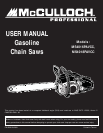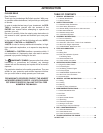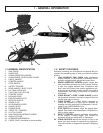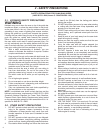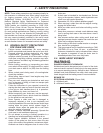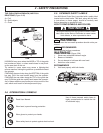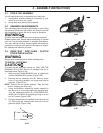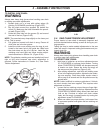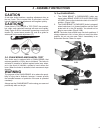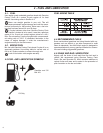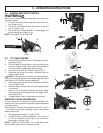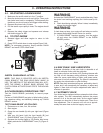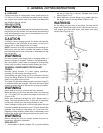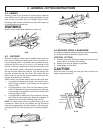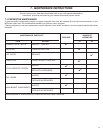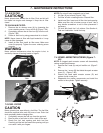
8
3 - ASSEMBLY INSTRUCTIONS
CAUTION
A new saw chain stretches, requiring adjustment after as
few as 5 cuts. This is normal with a new chain, and the
interval between future adjustments will lengthen quickly.
CAUTION
If saw chain is TOO LOOSE or TOO TIGHT, the sprocket,
bar, chain, and crankshaft bearings will wear more rapidly.
Study Figure 3-4B for information concerning correct cold
tension (A), correct warm tension (B), and as a guide for
when saw chain needs adjustment (C).
3-5. CHAIN BRAKE
®
MECHANICAL TEST
Your chain saw is equipped with a CHAIN BRAKE
®
that
reduces possibility of injury due to kickback. The brake is
activated if pressure is applied against brake lever when,
as in the event of kickback, operator’s hand strikes the
lever. When the brake is actuated, chain movement stops
abruptly.
WARNING
The purpose of the CHAIN BRAKE
®
is to reduce the possi-
bility of injury due to kickback; however, it cannot provide
the intended measure of protection if the saw is operated
carelessly.
Always test the CHAIN BRAKE
®
before using your saw and
periodically while on the job.
To Test CHAIN BRAKE
®
:
1. The CHAIN BRAKE
®
is DISENGAGED (chain can
move) when BRAKE LEVER IS PULLED BACK AND
LOCKED. Be sure the chain brake latch is in the OFF
position. (Figure 3-5A).
2. The CHAIN BRAKE
®
is ENGAGED (chain is stopped)
when brake lever is in forward position and the chain
brake latch is in the ON position. You should not be
able to move chain (Figure 3-5B).
NOTE: The brake lever should snap into both positions. If
strong resistance is felt, or lever does not move into either
position, do not use your saw. Take it immediately to an
Authorized Service Center for repair.
3-4B
A
C
B
3-5A
3-5B
OFF
ON



